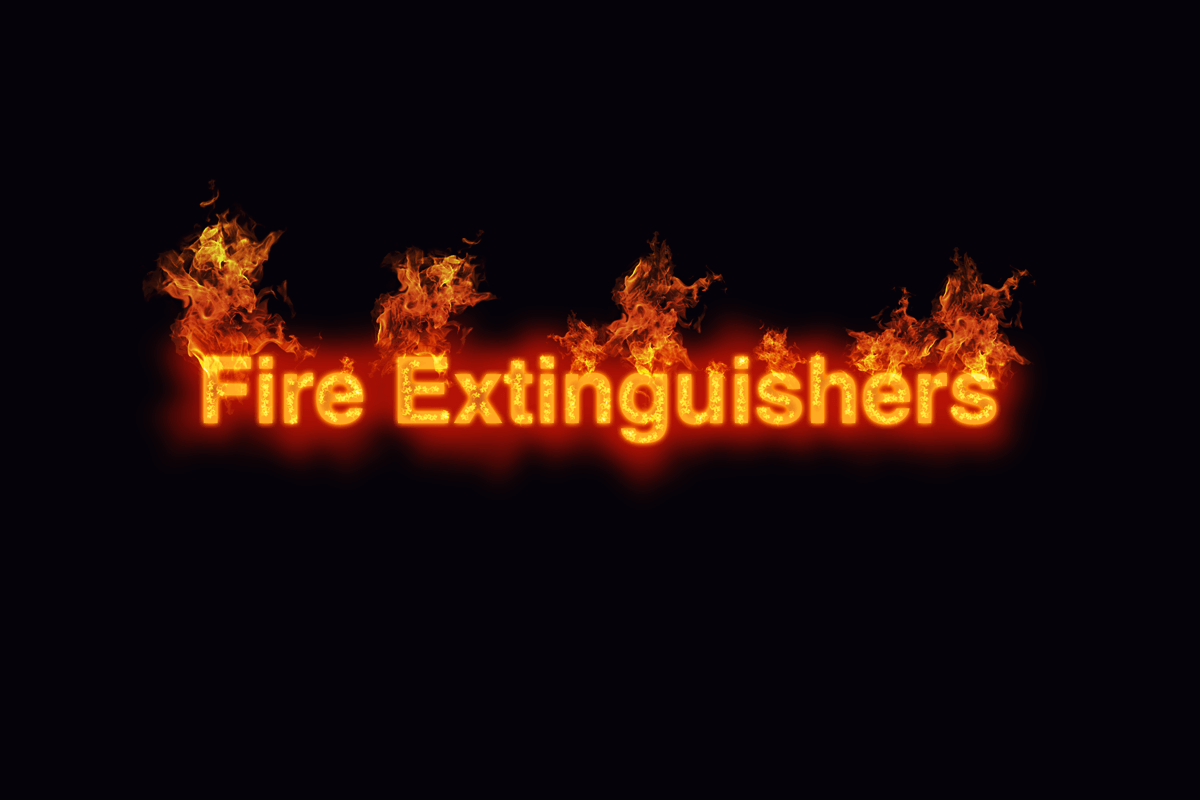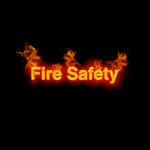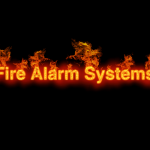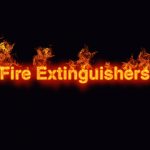All new fire extinguishers in the UK are painted with a rich red colour, which is referred to as Signal Red. The colour codes are on the label. Although it is quite possible to see fire extinguishers with a solid colour other than red (The old-style colour code), they are legally allowed but must be replaced at the end of their useful life. However, the Green Halon extinguishers are not permitted, and they are now illegal.
Because of the colour code restrictions and regulations, the UK Fire extinguishers must conform to strict standards. That is because fires are classified under different types of classes.
Different classes of fires demand different types of fire extinguishers. For this reason, if there is a need for a business owner to have a fire extinguisher at their business premises, it is imperative (for both employees and business owners) to identify the right one to use. Furthermore, they must ensure it meets the appropriate British Standards before purchase.
Certification happens on-site after delivery for commercial and public entities or buildings.
Contents
- 1 What Are the Fire Extinguisher Colours?
- 2 Why Is Extinguisher Colour Coding Necessary?
- 3 Why Did The Fire Extinguisher Colour Change?
- 4 What Are The Different Classes Of Fire?
- 5 Conclusion
What Are the Fire Extinguisher Colours?
The five fire extinguisher colours are:
- Blue – Dry Powder
- Black – Carbon Dioxide (CO2)
- Cream – Foam
- Red – Water (Spray and Mist)
- Yellow – Wet Chemical
Fire extinguishers are divided into five colour codes. As such, it is paramount to get the correct fire extinguisher based on the risk at hand. This is not just in terms of the legal compliance under the The Regulatory Reform (Fire Safety) Order 2005, but because they save lives. Fire extinguishers are available in the following colour codes:
1. Blue (Dry Powder Extinguishers)
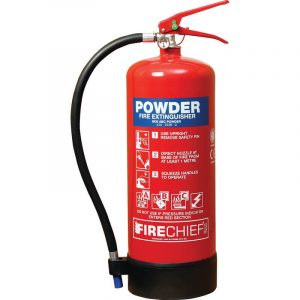 Blue label fire extinguishers are sometimes known as ‘ABC’ extinguishers because they can be used on Class A, B, and C fire types. However, this fire extinguisher must not be used in enclosed spaces because it is very easy to inhale the powder, and cleaning is not easy.
Blue label fire extinguishers are sometimes known as ‘ABC’ extinguishers because they can be used on Class A, B, and C fire types. However, this fire extinguisher must not be used in enclosed spaces because it is very easy to inhale the powder, and cleaning is not easy.
The standard dry powder can be used on some electrical fires, while the special dry powder extinguisher may be used on fires involving flammable metals.
How Do a Dry Powder Extinguishers Work?
Dry powder or chemical extinguishers work by coating the fuel or burning material with a thin layer of dust. This separates the fuel from the oxygen. It also works by interrupting the chemical reaction of a fire, which is why they are effective in putting out fires from classes A, B, and C.
Used on:
- Organic material like wood, flammable material, coal, cardboard, paper, etc
- Flammable liquids like diesel, petrol, oil, turpentine, etc.
- Fire involving electrical equipment of up to 1000 volts
- Fires involving flammable gasses like LPG (liquid petroleum gas) and acetylene
NOTE: Special dry powder extinguisher can only be used on flammable metals like magnesium and titanium.
Not used on:
- Cooking oil fires
- Over 1000V electrical fires
- In enclosed spaces like residential homes, offices, etc.
Who Might Need Dry Powder Extinguishers?
- Welding and flame cutting businesses
- Premises with large boiler rooms
- Buildings using flammable gases for chemical processes
- Garage forecourts
2. Black (Carbon Dioxide (CO2) Extinguishers)
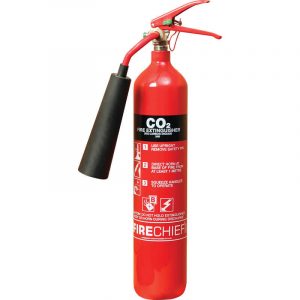 Black labelled fire extinguishers are CO2 fire suppressers, and they are primarily used for electrical fires. They are also used in computer server rooms. They can also be used in Class B fire types.
Black labelled fire extinguishers are CO2 fire suppressers, and they are primarily used for electrical fires. They are also used in computer server rooms. They can also be used in Class B fire types.
How Does a Carbon Dioxide (CO2) Extinguishers Work?
A Carbon Dioxide (CO2) fire extinguisher works by suffocating the fire by displacing the oxygen needed to burn with CO2. For it to be effective, the CO2 must be placed close to the source of the fire.
Used on:
- Flammable liquid type of fire like diesel, petrol, paint, etc
- Electrical related fire
Not used on:
- Kitchen fires
- Flammable materials
- Organic material like fabric, cardboard, wood, or paper
Who Might Need Carbon Dioxide Extinguishers?
- Building sites
- Server rooms
- Commercial kitchens
- Office blocks
- Buildings with electrical equipment
NOTE: all vehicles must carry 2kg of CO2 fire extinguisher as standard.
3. Cream (Foam Extinguishers)
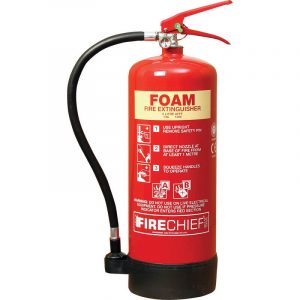 This is another common extinguisher and designed for Class B type of fire. It also works best for Class A type of fires. Nevertheless, a foam fire extinguisher is recommended for fires related to flammable liquids such as diesel, petrol, alcohol, oils, etc. the foam produced by the extinguisher is non-toxic.
This is another common extinguisher and designed for Class B type of fire. It also works best for Class A type of fires. Nevertheless, a foam fire extinguisher is recommended for fires related to flammable liquids such as diesel, petrol, alcohol, oils, etc. the foam produced by the extinguisher is non-toxic.
How Does a Foam Extinguisher Work?
This fire extinguisher works by forming a blanket over the burning surface. When used, it not only cools the burning material/surface but starves the fire by removing oxygen.
Used on:
- Organic materials like coal, wood, flammable material, cardboard, paper, and others
- Flammable liquids like turpentine, paint, petrol, oil, and others
Not used on:
- Flammable metal fires
- Electrical fires
- Kitchen fires
Who Might Need a Foam Extinguisher?
- Buildings made of wood
- Buildings with organic materials like offices, warehouses, residential homes, hospitals, nurseries, schools, etc
NOTE: a majority of buildings need both water and foam extinguishers.
4. Red (Water Extinguishers)
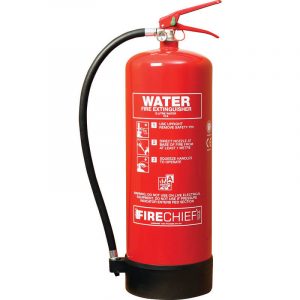 Water-based extinguishers are the most common type of extinguisher found in many businesses and public buildings and the cheapest option.
Water-based extinguishers are the most common type of extinguisher found in many businesses and public buildings and the cheapest option.
They are commonly recommended for hotels, residential areas, and public places. These are designed for Class A type of fires and carry the original ‘Signal Red’ colour label. For this reason, a water-based fire extinguisher must not be used on electrical fire under any circumstance. That is because water is conductive and may cause further safety issues.
How Does a Water Extinguisher Work?
Water fire extinguishers work by squirting a jet of H2O at the fire. It achieves this by extinguishing the fire at the source by spraying a jet of water. It douses the flame and prevents the material from re-igniting (by making the flammable material wet).
Used on:
- Coal and wood fires
- Textile and fabrics fires
- Cardboard and paper fires
Not used on:
- Kitchen (cooking oil) fires
- Electrical or electrical equipment related fires
- Flammable liquid or gas fires
Who Might Need Water Extinguishers?
- Buildings made of wood
- Buildings with organic material (offices, schools, residential homes, hospitals, etc.)
- Buildings that store organic material (warehouses, barn, and stores)
5. Yellow (Wet Chemical Extinguishers)
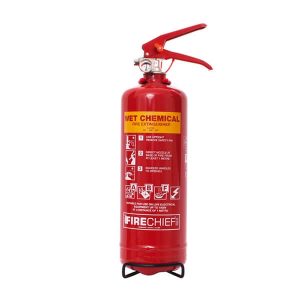 Yellow labelled fire extinguishers are wet chemical-based extinguishers and designed for Class F types of fires. It is important to note that Class F fires generally occur in professional kitchens and other spaces where oil is being heated to high temperatures. Although this type of fire extinguisher can be used for Class A type of fire, many businesses will mainly prefer water or foam extinguishers for this purpose.
Yellow labelled fire extinguishers are wet chemical-based extinguishers and designed for Class F types of fires. It is important to note that Class F fires generally occur in professional kitchens and other spaces where oil is being heated to high temperatures. Although this type of fire extinguisher can be used for Class A type of fire, many businesses will mainly prefer water or foam extinguishers for this purpose.
How Does a Wet Chemical Extinguisher Work?
This type of fire extinguisher often comes with a long lance that helps deploy the foam safely. The wet chemical is a thick, soapy foam that functions as a blanket when used. It stops oxygen from reacting with the fire and starves the flame.
Used on:
- Cooking fat fires
- Organic material fires like wood, coal, cardboard, paper, etc
Not used on:
- Fire involving flammable metals
- Electrical fires
- Flammable liquids fires
- Flammable gas fires
Who Might Need a Wet Chemical Extinguisher?
- Canteens
- Restaurants
- Professional kitchens
Why Is Extinguisher Colour Coding Necessary?
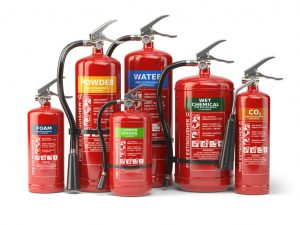 Colour coding is vital as it helps anyone identify which is which. This is especially important when there is a fire. In fact, all fire extinguishers are supposed to have their sticky tag showing, and preferably they should be mounted in a way that their carrying grip is 1 meter above the floor level. There should be a sign near the fire extinguisher.
Colour coding is vital as it helps anyone identify which is which. This is especially important when there is a fire. In fact, all fire extinguishers are supposed to have their sticky tag showing, and preferably they should be mounted in a way that their carrying grip is 1 meter above the floor level. There should be a sign near the fire extinguisher.
Colour coding helps prevent further hazards during a fire. For example, using a water-based fire extinguisher in an oil-related fire; will only increase the rate of fire spread, and anyone close is at a high risk of getting burned by the oil.
Why Did The Fire Extinguisher Colour Change?
Before 1997, fire extinguisher cylinders were completely coloured with the colour distinguishing its type. For example, foam extinguishers were completely coloured cream. The dry powder extinguishers were completely coloured blue.
However, the standard of the fire extinguisher colour changes to the ‘Signal Red’ for two main reasons: –
- The colour red is associated with danger and fire – The first reason was that red is a colour associated with danger, caution, or fire.
- It is easy to see red colour – Red is a colour that can be seen easily even in darker environments like a smoke-filled room.
What Are The Different Classes Of Fire?
Different fire extinguisher’s colours tell you which classes of fire it is best used for. Well, there are six classes of fires which are: –
- Class A: Generally includes combustible materials like paper, wood, fabric, coal, etc. They are fires caused by flammable solids.
- Class B: These are fires that are caused by Flammable liquids like alcohol, paint, petrol, etc
- Class C: These are fires caused by farmable gases like methane, hydrogen, etc
- Class D: These are fires caused by combustible metals and chemicals like potassium, magnesium, and others
- Electrical fire: These are fires caused by electrical equipment like heaters, batteries, etc. Once the electrical aspect is eliminated, a person can use any other fire extinguisher based on the fuel for the fire
- Class F: These are fires related to oil like cooking oils
Conclusion
Anyone expected to use a fire extinguisher needs training, instruction, and learn how to use the equipment. Fire service professionals recommend that a person only tackle a fire if they know what they are doing for safety purposes. A fire extinguisher service must be carried out regularly (preferably every year).

